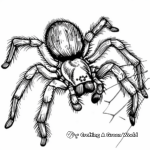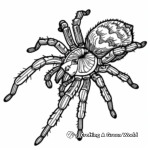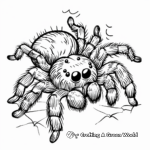All of the coloring pages displayed on this page are free for personal use (view full use policy). Any brands, characters, or trademarks featured in our coloring pages are owned by their respective holders and depicted here as fan art.
Please enjoy these spider coloring pages!
Amazing Arachnids: Spider Coloring Pages




Creepy Crawly Spider Coloring Pages




Exotic Tarantula Spider Coloring Pages




Simple Spider Shapes for Young Kids Coloring Pages




Detailed Black Widow Spider Coloring Pages for Adults




Cartoon-like, Kid-friendly Spider Coloring Pages




Jumping Spider Coloring Pages




Enchanting Orb Weaver Spider Coloring Pages




Exquisite Golden Silk Orb-Weaver Spider Coloring Page




Spider Web Morning Dew Coloring Pages




Vibrant Peacock Spider Coloring Pages




Spooky Halloween Spider Coloring Pages




Spider in Nature Coloring Pages




Mysterious Trapdoor Spider Coloring Pages




Colorful Lynx Spider Coloring Pages




Tips For Coloring Spiders
What colors should I use for a spider coloring page?
Most spiders are brown or black, but some species can be colorful. Primary colors you may need are different shades of brown, various greys, and black. However, if you are coloring a species like the peacock spider, you might also need blue, red, yellow and green. More exotic spiders like the Blue Tarantula require bright blue.
How can I add more detail and realism to my spider coloring?
To achieve realism in your spider coloring, pay attention to the texture and pattern of the spider’s body and legs. Use different shades of the main color for highlighting and shadowing. Lighter shades can be used for the belly and darker shades for the back and legs. Adding light marks to indicate the texture of the hair on its body will also add to realism.
Are there any remarkable features of spiders I should pay attention to while coloring?
Yes, pay attention to the spider’s eyes. Most spiders have eight eyes, and this can be a fun detail to incorporate into your coloring. Additionally, consider the unique patterns on the spider’s body or its web. Following these patterns accurately can make the image more realistic. Lastly, many spiders have hairy bodies and legs, so incorporate lines or shading to show this.
Can you provide some interesting facts about spiders that I could incorporate into my art?
Absolutely. Spiders are arachnids, not insects. They have eight legs, and most have eight eyes. Some spiders like the orb weaver make beautifully patterned webs, which could be a great background in your coloring artwork. Spiders play an essential ecological role in controlling the population of insects. Adding a few prey insects in your art can be an excellent way to recognize this.
Related Coloring Pages
About Our Coloring Pages
All of the coloring pages displayed on this page are free for personal use. You have our express permission to download, print, color, and enjoy these pages at your own leisure and convenience. Each piece of artwork on this page has been chosen to inspire creativity and make the world of coloring engaging and enjoyable for all age groups. This permission extends to small non-commercial group settings like classrooms or therapy settings - you have our permission to print these for free distribution to small groups.
This permission is granted strictly for non-commercial uses. These images can not be resold, republished, or used for commercial purposes in any form or method. You may not sell the final colored versions, or use them as design elements in a product that is sold. Please contact us for commercial licensing options.
Our priority is to support and inspire creativity among those who love to color. Please join us in honoring this purpose by adhering to these guidelines. Happy Coloring!
